英语作文5篇
英语写作优秀范文5篇
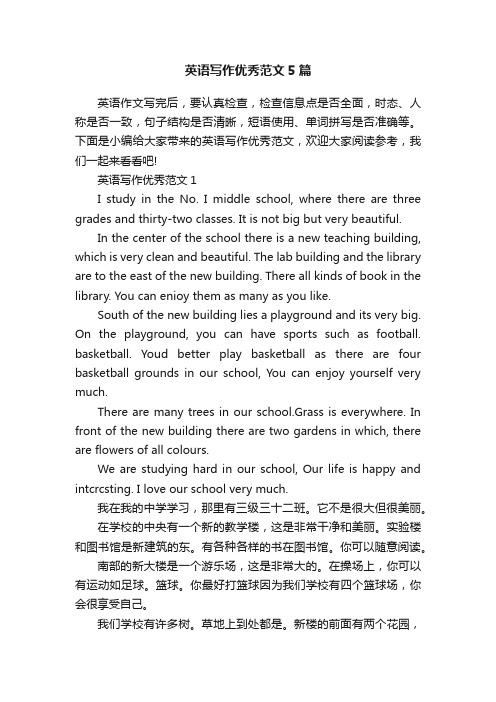
英语写作优秀范文5篇英语作文写完后,要认真检查,检查信息点是否全面,时态、人称是否一致,句子结构是否清晰,短语使用、单词拼写是否准确等。
下面是小编给大家带来的英语写作优秀范文,欢迎大家阅读参考,我们一起来看看吧!英语写作优秀范文1I study in the No. I middle school, where there are three grades and thirty-two classes. It is not big but very beautiful.In the center of the school there is a new teaching building, which is very clean and beautiful. The lab building and the library are to the east of the new building. There all kinds of book in the library. You can enioy them as many as you like.South of the new building lies a playground and its very big. On the playground, you can have sports such as football. basketball. Youd better play basketball as there are four basketball grounds in our school, You can enjoy yourself very much.There are many trees in our school.Grass is everywhere. In front of the new building there are two gardens in which, there are flowers of all colours.We are studying hard in our school, Our life is happy and intcrcsting. I love our school very much.我在我的中学学习,那里有三级三十二班。
高考 英语作文 范文5篇
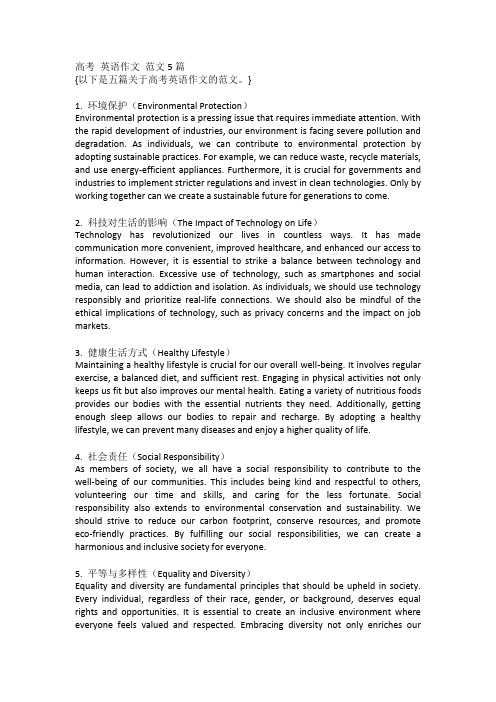
高考英语作文范文5篇{以下是五篇关于高考英语作文的范文。
}1. 环境保护(Environmental Protection)Environmental protection is a pressing issue that requires immediate attention. With the rapid development of industries, our environment is facing severe pollution and degradation. As individuals, we can contribute to environmental protection by adopting sustainable practices. For example, we can reduce waste, recycle materials, and use energy-efficient appliances. Furthermore, it is crucial for governments and industries to implement stricter regulations and invest in clean technologies. Only by working together can we create a sustainable future for generations to come.2. 科技对生活的影响(The Impact of Technology on Life)Technology has revolutionized our lives in countless ways. It has made communication more convenient, improved healthcare, and enhanced our access to information. However, it is essential to strike a balance between technology and human interaction. Excessive use of technology, such as smartphones and social media, can lead to addiction and isolation. As individuals, we should use technology responsibly and prioritize real-life connections. We should also be mindful of the ethical implications of technology, such as privacy concerns and the impact on job markets.3. 健康生活方式(Healthy Lifestyle)Maintaining a healthy lifestyle is crucial for our overall well-being. It involves regular exercise, a balanced diet, and sufficient rest. Engaging in physical activities not only keeps us fit but also improves our mental health. Eating a variety of nutritious foods provides our bodies with the essential nutrients they need. Additionally, getting enough sleep allows our bodies to repair and recharge. By adopting a healthy lifestyle, we can prevent many diseases and enjoy a higher quality of life.4. 社会责任(Social Responsibility)As members of society, we all have a social responsibility to contribute to the well-being of our communities. This includes being kind and respectful to others, volunteering our time and skills, and caring for the less fortunate. Social responsibility also extends to environmental conservation and sustainability. We should strive to reduce our carbon footprint, conserve resources, and promote eco-friendly practices. By fulfilling our social responsibilities, we can create a harmonious and inclusive society for everyone.5. 平等与多样性(Equality and Diversity)Equality and diversity are fundamental principles that should be upheld in society. Every individual, regardless of their race, gender, or background, deserves equal rights and opportunities. It is essential to create an inclusive environment where everyone feels valued and respected. Embracing diversity not only enriches oursociety but also fosters innovation and creativity. We should challenge stereotypes, promote tolerance, and strive for a more equitable world.希望以上范文对你的高考英语作文有所帮助!祝你取得好成绩!。
英语作文5篇带翻译带中文

英语作文5篇带翻译带中文1. I woke up this morning feeling refreshed and ready to take on the day. The sun was shining through my window, casting a warm glow on my face. It was the perfect start to a new day.2. As I walked down the street, I couldn't help but notice the vibrant colors of the flowers in bloom. The air was filled with the sweet scent of spring, and it put a smile on my face. It's amazing how something as simple as nature can brighten your day.3. I decided to treat myself to a cup of coffee at my favorite café. The aroma of freshly brewed coffee filled the air as I took my first sip. It was like a warm hug for my soul, instantly making me feel more awake and alive.4. After finishing my coffee, I headed to the park fora leisurely stroll. The sound of birds chirping andchildren laughing created a joyful atmosphere. It remindedme of the importance of finding joy in the little things in life.5. As the day came to an end, I found myself reflecting on the events of the day. It was a day filled with simple pleasures and moments of happiness. I realized that sometimes, it's the small things that make the biggest impact on our lives.1. 今早我醒来时感觉精神焕发,准备好迎接新的一天。
英语作文5篇
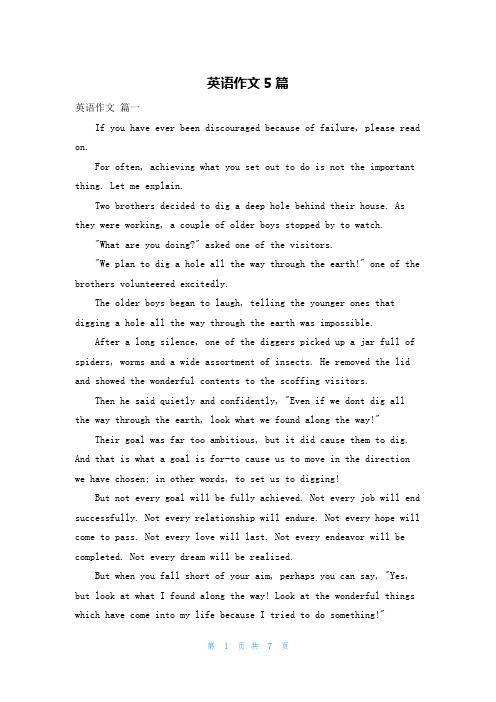
英语作文5篇英语作文篇一If you have ever been discouraged because of failure, please read on.For often, achieving what you set out to do is not the important thing. Let me explain.Two brothers decided to dig a deep hole behind their house. As they were working, a couple of older boys stopped by to watch."What are you doing?" asked one of the visitors."We plan to dig a hole all the way through the earth!" one of the brothers volunteered excitedly.The older boys began to laugh, telling the younger ones that digging a hole all the way through the earth was impossible.After a long silence, one of the diggers picked up a jar full of spiders, worms and a wide assortment of insects. He removed the lid and showed the wonderful contents to the scoffing visitors.Then he said quietly and confidently, "Even if we dont dig all the way through the earth, look what we found along the way!"Their goal was far too ambitious, but it did cause them to dig. And that is what a goal is for-to cause us to move in the direction we have chosen; in other words, to set us to digging!But not every goal will be fully achieved. Not every job will end successfully. Not every relationship will endure. Not every hope will come to pass. Not every love will last. Not every endeavor will be completed. Not every dream will be realized.But when you fall short of your aim, perhaps you can say, "Yes, but look at what I found along the way! Look at the wonderful things which have come into my life because I tried to do something!"It is in the digging that life is lived. And I believe it is joy in the journey, in the end, that truly matters.英语作文篇二Important Education“don’t tell any lies to others, and if you do that, you will harm yourself and the people who belive on you”, my mother told me when I was very young.Children often try to tell lies to someone because they don’t know what it means. The same thing had happened to me too. My mother found the problem and tried her best to solve it. Luckily, I found what a serious problem it is and changed it.Just like this story, the most important education of me, does not come form school but form my mum. She lets me know what a man should do or should not do.“I’ll buy any books you want, but you have to read them all.” My mother promised me.Just like what she said, she bought many books to me, including comic books, scientist-know-ledge books, story books and many other kinds of books.When I was young, my mum always read a story to me before sleeping. For example, The complete words of Shakespeare. I can’t understand it very well, but find interested in it. I have read a lot of books since then, and now I have realized how useful they can do. Books help me know more and think deeply. For all of this, I’m very grateful of my mum.Recently, I passed my 16 birthday. I know l have to face to more responsibility. When I turned to review the way I grow up, I found what an important role my mum played in my education. Good parentsare much better than a perfect school. It is ture.Thank you, mum.重要教育“不要告诉任何谎言的人,如果你这样做,你会伤害自己和那些相信你”,我的母亲告诉我,在我很小的时候。
英语作文5篇带翻译带中文
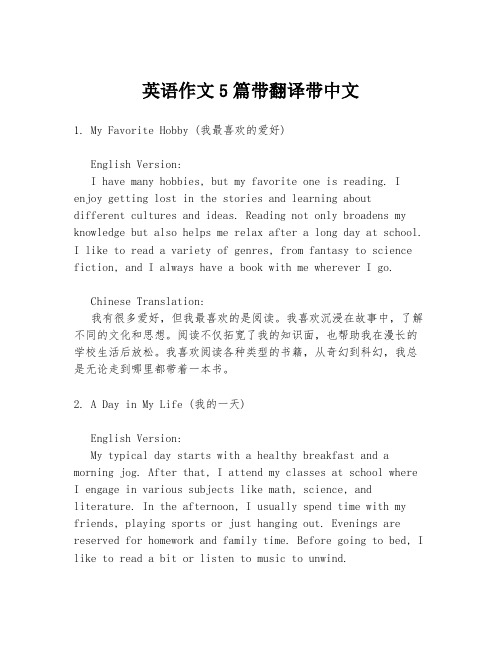
英语作文5篇带翻译带中文1. My Favorite Hobby (我最喜欢的爱好)English Version:I have many hobbies, but my favorite one is reading. I enjoy getting lost in the stories and learning aboutdifferent cultures and ideas. Reading not only broadens my knowledge but also helps me relax after a long day at school.I like to read a variety of genres, from fantasy to science fiction, and I always have a book with me wherever I go.Chinese Translation:我有很多爱好,但我最喜欢的是阅读。
我喜欢沉浸在故事中,了解不同的文化和思想。
阅读不仅拓宽了我的知识面,也帮助我在漫长的学校生活后放松。
我喜欢阅读各种类型的书籍,从奇幻到科幻,我总是无论走到哪里都带着一本书。
2. A Day in My Life (我的一天)English Version:My typical day starts with a healthy breakfast and a morning jog. After that, I attend my classes at school where I engage in various subjects like math, science, and literature. In the afternoon, I usually spend time with my friends, playing sports or just hanging out. Evenings are reserved for homework and family time. Before going to bed, I like to read a bit or listen to music to unwind.Chinese Translation:我的一天通常以健康的早餐和晨跑开始。
高考 英语作文范文5篇
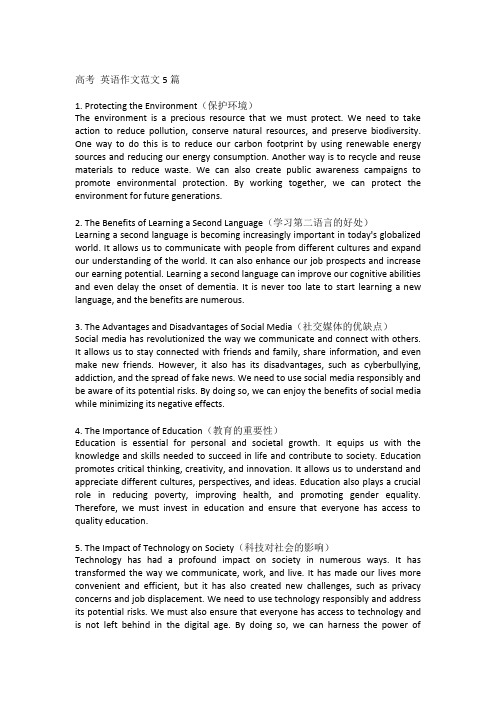
高考英语作文范文5篇1. Protecting the Environment(保护环境)The environment is a precious resource that we must protect. We need to take action to reduce pollution, conserve natural resources, and preserve biodiversity. One way to do this is to reduce our carbon footprint by using renewable energy sources and reducing our energy consumption. Another way is to recycle and reuse materials to reduce waste. We can also create public awareness campaigns to promote environmental protection. By working together, we can protect the environment for future generations.2. The Benefits of Learning a Second Language(学习第二语言的好处)Learning a second language is becoming increasingly important in today's globalized world. It allows us to communicate with people from different cultures and expand our understanding of the world. It can also enhance our job prospects and increase our earning potential. Learning a second language can improve our cognitive abilities and even delay the onset of dementia. It is never too late to start learning a new language, and the benefits are numerous.3. The Advantages and Disadvantages of Social Media(社交媒体的优缺点)Social media has revolutionized the way we communicate and connect with others. It allows us to stay connected with friends and family, share information, and even make new friends. However, it also has its disadvantages, such as cyberbullying, addiction, and the spread of fake news. We need to use social media responsibly and be aware of its potential risks. By doing so, we can enjoy the benefits of social media while minimizing its negative effects.4. The Importance of Education(教育的重要性)Education is essential for personal and societal growth. It equips us with the knowledge and skills needed to succeed in life and contribute to society. Education promotes critical thinking, creativity, and innovation. It allows us to understand and appreciate different cultures, perspectives, and ideas. Education also plays a crucial role in reducing poverty, improving health, and promoting gender equality. Therefore, we must invest in education and ensure that everyone has access to quality education.5. The Impact of Technology on Society(科技对社会的影响)Technology has had a profound impact on society in numerous ways. It has transformed the way we communicate, work, and live. It has made our lives more convenient and efficient, but it has also created new challenges, such as privacy concerns and job displacement. We need to use technology responsibly and address its potential risks. We must also ensure that everyone has access to technology and is not left behind in the digital age. By doing so, we can harness the power oftechnology to create a better world for all.。
英语作文范文5篇带翻译
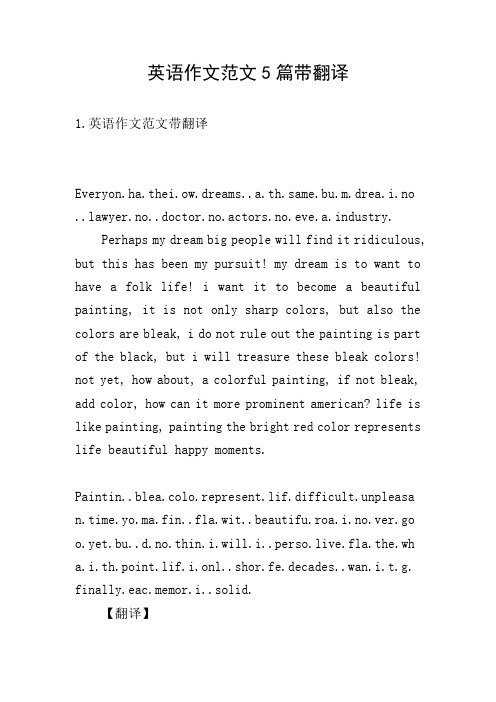
英语作文范文5篇带翻译1.英语作文范文带翻译Everyon.ha.thei.ow.dreams..a.th.same.bu.m.drea.i.no wyer.no..doctor.no.actors.no.eve.a.industry.Perhaps my dream big people will find it ridiculous, but this has been my pursuit! my dream is to want to have a folk life! i want it to become a beautiful painting, it is not only sharp colors, but also the colors are bleak, i do not rule out the painting is part of the black, but i will treasure these bleak colors! not yet, how about, a colorful painting, if not bleak, add color, how can it more prominent american? life is like painting, painting the bright red color represents life beautiful happy moments.Paintin..blea.colo.represent.lif.difficult.unpleasa n.time.yo.ma.fin..fla.wit..beautifu.roa.i.no.ver.go o.yet.bu..d.no.thin.i.will.i..perso.live.fla.the.wh a.i.th.point.lif.i.onl..shor.fe.decades..wan.i.t.g. finally.eac.memor.i..solid.【翻译】每个人都有自己的梦想,我也一样.但是我的梦想不是律师,不是医生,不是演员,甚至不是一种行业!我的梦想也许大人们会觉得可笑,但是,这是我一直追寻的!我的梦想是想要自己有一个七彩的人生!我要它成为一幅美丽的画,它不但要有鲜明的颜色,也要有暗淡的颜色,我不排除这幅画有一部分的黑色,我反而会很珍惜这些暗淡的颜色!不是吗,试问一下,一幅色彩鲜艳的画,如果不加一点暗淡的颜色,又怎能更突出它的美呢?人生就象画一样,画中鲜艳的颜色就代表着人生美丽快乐的时光.画中暗淡的颜色就代表着人生遭遇困难,不愉快的时候.也许你会觉得拥有一条平坦美丽的路不是很好吗,但我并不觉得.一个人如果一生平坦那有什么意思呢?人生只有短短几十年,我要他走到最后时,每一个回忆都事充实的!2.英语作文范文带翻译Onc..rea.th.stor.tha.th.littl.eagle.neede.t.practic .flyin.i.th.clif.befor.the.coul.fly.Th.successfu.on e.coul.fl.an.becam.th.stron.bird.whil.th.faile.one. woul.cras.an.the.died.Th.mothe.eagle.ar.bruta.t.th. babies.bu.thi.i.th.pric.o.growin.up.Th.littl.eagle. petition.I.make.m.thin.o.th.children.som.parent.spoi.th.kid.an.the.don’.realiz.i.wil.destro.thei.children.Th. childre.nee.t.lear.th.lessons.s.tha.the.ca.b.th.tou g.person.Th.roa.o.bein.matur.need.th.price.曾经我读到一个故事, 小鹰需要在会飞前在悬崖上练习飞翔。
高分英语作文范文五篇
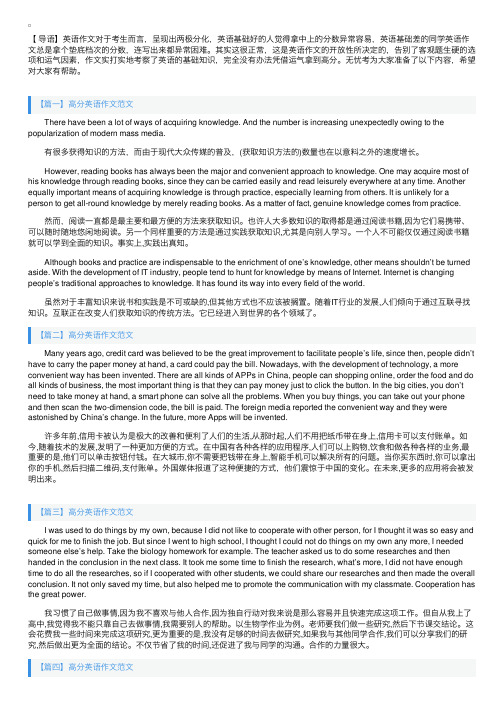
【导语】英语作⽂对于考⽣⽽⾔,呈现出两极分化,英语基础好的⼈觉得拿中上的分数异常容易,英语基础差的同学英语作⽂总是拿个垫底档次的分数,连写出来都异常困难。
其实这很正常,这是英语作⽂的开放性所决定的,告别了客观题⽣硬的选项和运⽓因素,作⽂实打实地考察了英语的基础知识,完全没有办法凭借运⽓拿到⾼分。
⽆忧考为⼤家准备了以下内容,希望对⼤家有帮助。
【篇⼀】⾼分英语作⽂范⽂ There have been a lot of ways of acquiring knowledge. And the number is increasing unexpectedly owing to the popularization of modern mass media. 有很多获得知识的⽅法,⽽由于现代⼤众传媒的普及,(获取知识⽅法的)数量也在以意料之外的速度增长。
However, reading books has always been the major and convenient approach to knowledge. One may acquire most of his knowledge through reading books, since they can be carried easily and read leisurely everywhere at any time. Another equally important means of acquiring knowledge is through practice, especially learning from others. It is unlikely for a person to get all-round knowledge by merely reading books. As a matter of fact, genuine knowledge comes from practice. 然⽽,阅读⼀直都是最主要和最⽅便的⽅法来获取知识。
5篇英语作文带翻译
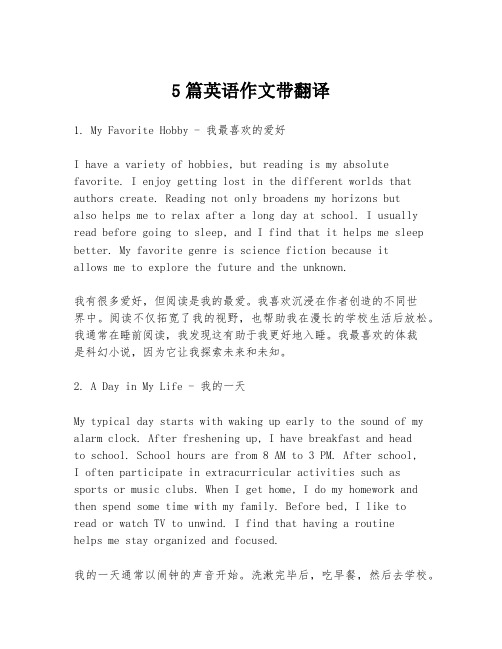
5篇英语作文带翻译1. My Favorite Hobby - 我最喜欢的爱好I have a variety of hobbies, but reading is my absolute favorite. I enjoy getting lost in the different worlds that authors create. Reading not only broadens my horizons butalso helps me to relax after a long day at school. I usually read before going to sleep, and I find that it helps me sleep better. My favorite genre is science fiction because itallows me to explore the future and the unknown.我有很多爱好,但阅读是我的最爱。
我喜欢沉浸在作者创造的不同世界中。
阅读不仅拓宽了我的视野,也帮助我在漫长的学校生活后放松。
我通常在睡前阅读,我发现这有助于我更好地入睡。
我最喜欢的体裁是科幻小说,因为它让我探索未来和未知。
2. A Day in My Life - 我的一天My typical day starts with waking up early to the sound of my alarm clock. After freshening up, I have breakfast and headto school. School hours are from 8 AM to 3 PM. After school,I often participate in extracurricular activities such as sports or music clubs. When I get home, I do my homework and then spend some time with my family. Before bed, I like toread or watch TV to unwind. I find that having a routinehelps me stay organized and focused.我的一天通常以闹钟的声音开始。
英语作文范文5篇
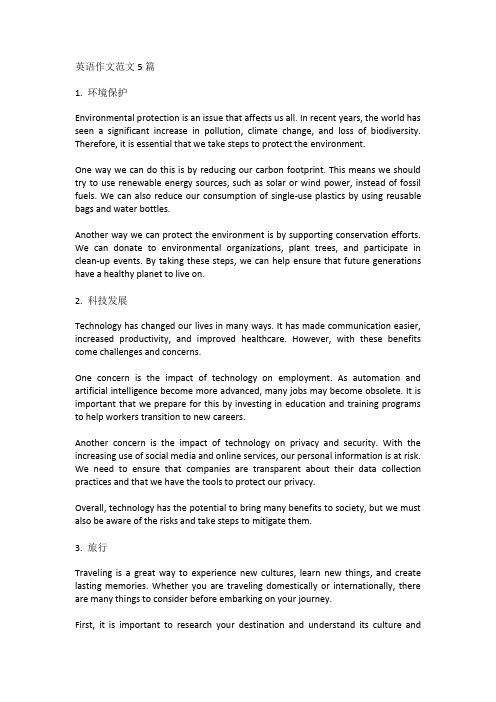
英语作文范文5篇1. 环境保护Environmental protection is an issue that affects us all. In recent years, the world has seen a significant increase in pollution, climate change, and loss of biodiversity. Therefore, it is essential that we take steps to protect the environment.One way we can do this is by reducing our carbon footprint. This means we should try to use renewable energy sources, such as solar or wind power, instead of fossil fuels. We can also reduce our consumption of single-use plastics by using reusable bags and water bottles.Another way we can protect the environment is by supporting conservation efforts. We can donate to environmental organizations, plant trees, and participate in clean-up events. By taking these steps, we can help ensure that future generations have a healthy planet to live on.2. 科技发展Technology has changed our lives in many ways. It has made communication easier, increased productivity, and improved healthcare. However, with these benefits come challenges and concerns.One concern is the impact of technology on employment. As automation and artificial intelligence become more advanced, many jobs may become obsolete. It is important that we prepare for this by investing in education and training programs to help workers transition to new careers.Another concern is the impact of technology on privacy and security. With the increasing use of social media and online services, our personal information is at risk. We need to ensure that companies are transparent about their data collection practices and that we have the tools to protect our privacy.Overall, technology has the potential to bring many benefits to society, but we must also be aware of the risks and take steps to mitigate them.3. 旅行Traveling is a great way to experience new cultures, learn new things, and create lasting memories. Whether you are traveling domestically or internationally, there are many things to consider before embarking on your journey.First, it is important to research your destination and understand its culture andcustoms. This will help you avoid any cultural faux pas and show respect to the local people.Second, you should plan your itinerary carefully to make the most of your time. This includes booking accommodations, transportation, and activities in advance.Finally, it is important to be mindful of your impact on the environment and local communities. This means avoiding activities that harm wildlife or damage the environment, supporting local businesses, and being respectful of local customs and traditions.Overall, traveling can be a rewarding and enriching experience, as long as we approach it with respect and consideration for others.4. 健康生活Maintaining a healthy lifestyle is essential for our physical and mental well-being. This includes eating a balanced diet, getting regular exercise, and managing stress. One way to improve our diet is to eat more whole foods and fewer processed foods. Whole foods are nutrient-dense and provide our bodies with the vitamins and minerals we need to stay healthy. Processed foods, on the other hand, are often high in sugar, salt, and unhealthy fats.Regular exercise is also important for our health. It helps us maintain a healthy weight, reduce the risk of chronic diseases, and improve our mood. We should aim to get at least 30 minutes of moderate exercise most days of the week.Finally, managing stress is essential for our mental health. This can include practicing relaxation techniques, such as meditation or yoga, getting enough sleep, and seeking support from friends and family.Overall, by making small changes to our diet, exercise routine, and stress management, we can improve our overall health and well-being.5. 社会公正Social justice is the idea that all people should have equal access to opportunities and resources, regardless of their race, gender, or socioeconomic status. Unfortunately, many people still face discrimination and inequality in our society. One way to promote social justice is to advocate for policies that address systemic inequalities. This can include policies that promote equal access to education, healthcare, and employment opportunities.Another way to promote social justice is to support organizations that work to address these issues. This can include volunteering, donating money, or simply sharing information about their work on social media.Finally, it is important to examine our own biases and privilege and work to be more inclusive and understanding of others. This includes listening to diverse perspectives, challenging stereotypes and prejudices, and being an ally to marginalized communities.Overall, promoting social justice requires a collective effort to address systemic inequalities and promote equality and inclusion for all people.。
英语作文范文5篇

英语作文范文5篇1. 我的家人(My Family)My family is very important to me. There are four people in my family – my parents, my younger sister, and me. We live together in a small but cozy house.My parents are hardworking and loving. My father works as a teacher, and my mother is a nurse. They always support me in everything I do and encourage me to pursue my dreams. My younger sister is a playful and energetic girl. Although we sometimes argue, we also have a lot of fun together.In the evenings, we often gather around the dining table to have dinner as a family. We share our experiences, talk about our day, and laugh a lot. On weekends, we enjoy going for outings, watching movies, or playing board games.I feel truly blessed to have such a loving and supportive family. They are my pillar of strength and my source of happiness.2. 我的假期计划(My Holiday Plans)I am excited about the upcoming summer vacation. I have planned a variety of activities to make the most of my time off from school.Firstly, I am going to spend a week at the beach with my family. I love swimming and building sandcastles, so I am really looking forward to enjoying the sun, sand, and sea.After that, I have enrolled in a summer camp where I will learn horseback riding and archery. It will be a great opportunity for me to try something new and make new friends.In addition to these activities, I also plan to spend some time reading books, as I am an avid reader. I have a long list of books that I want to finish during the vacation.Overall, I am determined to make this holiday memorable by engaging in a mix of fun, learning, and relaxation.3. 环保意识(Environmental Awareness)Environmental awareness is crucial in today's world. It is our responsibility to protect and preserve the environment for future generations.There are several ways in which we can contribute to environmental conservation. Firstly, we should reduce, reuse, and recycle. By reducing our consumption, reusing items, and recycling waste, we can minimize the amount of waste that ends up in landfills.Secondly, we need to conserve energy. Turning off lights and electronic devices when not in use, using energy-efficient appliances, and opting for renewable energy sources are some ways to conserve energy and reduce our carbon footprint.Lastly, we should promote the use of eco-friendly transportation, such as walking, cycling, or using public transport. This helps reduce air pollution and congestion on the roads.By taking small steps in our daily lives, we can make a big difference in protecting the environment and creating a sustainable future.4. 我的梦想职业(My Dream Career)From a young age, I have always dreamt of becoming a doctor. The idea of helping people, making a positive impact on their lives, and contributing to the well-being of society has always fascinated me.I am aware that becoming a doctor requires years of hard work, dedication, and continuous learning. I am ready to invest my time and effort into studying medicine and acquiring the necessary skills and knowledge.Apart from the academic aspect, I also understand the importance of empathy and compassion in the medical profession. I believe that being a good doctor means not only treating the physical ailments but also caring for the emotional well-being of patients.I am excited about the challenges and rewards that come with this profession. I am confident that with determination and perseverance, I can turn my dream of becoming a doctor into a reality.5. 网络的影响(The Influence of the Internet)The internet has revolutionized the way we live and has had a profound impact on society. It has brought about numerous positive changes, but it also comes with its own set of challenges.On the positive side, the internet has made information easily accessible. We can now access a vast amount of knowledge with just a few clicks. It has also made communication more convenient, allowing us to connect with people from all over the world instantly.However, the internet has also led to some negative consequences. One of the major concerns is the excessive use of social media, which can lead to addiction, isolation, and a distorted sense of reality. Moreover, the spread of fake news and misinformation has become a significant issue, causing confusion and distrust among people.In conclusion, while the internet has brought many benefits, it is crucial to use it responsibly and be aware of its potential drawbacks. We must strive for a balance between utilizing the internet'sadvantages and mitigating its negative impact.希望以上范文能对您有所帮助,祝您写作顺利!。
高考英语作文范文5篇
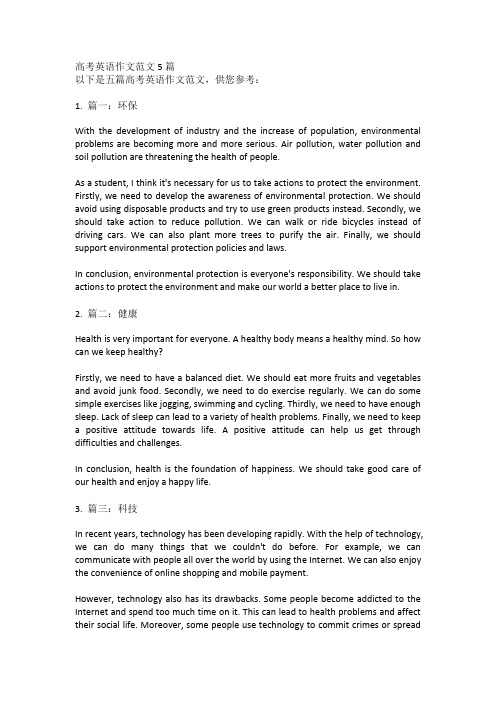
高考英语作文范文5篇以下是五篇高考英语作文范文,供您参考:1. 篇一:环保With the development of industry and the increase of population, environmental problems are becoming more and more serious. Air pollution, water pollution and soil pollution are threatening the health of people.As a student, I think it's necessary for us to take actions to protect the environment. Firstly, we need to develop the awareness of environmental protection. We should avoid using disposable products and try to use green products instead. Secondly, we should take action to reduce pollution. We can walk or ride bicycles instead of driving cars. We can also plant more trees to purify the air. Finally, we should support environmental protection policies and laws.In conclusion, environmental protection is everyone's responsibility. We should take actions to protect the environment and make our world a better place to live in.2. 篇二:健康Health is very important for everyone. A healthy body means a healthy mind. So how can we keep healthy?Firstly, we need to have a balanced diet. We should eat more fruits and vegetables and avoid junk food. Secondly, we need to do exercise regularly. We can do some simple exercises like jogging, swimming and cycling. Thirdly, we need to have enough sleep. Lack of sleep can lead to a variety of health problems. Finally, we need to keep a positive attitude towards life. A positive attitude can help us get through difficulties and challenges.In conclusion, health is the foundation of happiness. We should take good care of our health and enjoy a happy life.3. 篇三:科技In recent years, technology has been developing rapidly. With the help of technology, we can do many things that we couldn't do before. For example, we can communicate with people all over the world by using the Internet. We can also enjoy the convenience of online shopping and mobile payment.However, technology also has its drawbacks. Some people become addicted to the Internet and spend too much time on it. This can lead to health problems and affect their social life. Moreover, some people use technology to commit crimes or spreadfalse information.To sum up, technology is a double-edged sword. We should make good use of it and avoid its negative effects.4. 篇四:人际关系Interpersonal relationship is very important in our daily life. Good interpersonal relationship can bring us happiness and success, while bad interpersonal relationship can bring us trouble and failure.To build good interpersonal relationship, we need to respect others and treat them kindly. We should also learn to listen to others and try to understand their feelings and thoughts. Moreover, we should be honest and trustworthy. We should keep our promises and never betray others.In conclusion, good interpersonal relationship is the key to a happy and successful life. We should cherish and maintain it.5. 篇五:教育Education is the key to success. It can help us acquire knowledge and skills, and broaden our horizons. However, education is not only about academic achievements. It's also about developing our moral values and social responsibility.As students, we should take our studies seriously and try to achieve the best results. At the same time, we should also participate in social activities and contribute to the society. We can volunteer in community services or environmental protection projects.In conclusion, education is not only about getting high grades, but also about becoming a responsible and caring person. We should make the most of our education and use it to make a better world.。
高考 英语作文 范文5篇
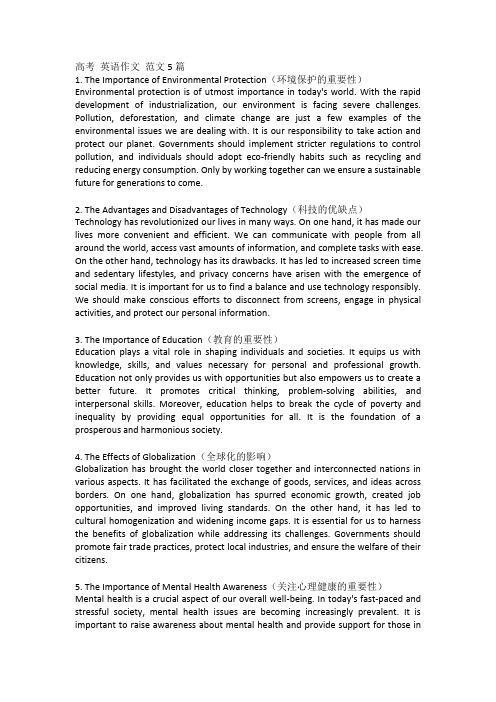
高考英语作文范文5篇1. The Importance of Environmental Protection(环境保护的重要性)Environmental protection is of utmost importance in today's world. With the rapid development of industrialization, our environment is facing severe challenges. Pollution, deforestation, and climate change are just a few examples of the environmental issues we are dealing with. It is our responsibility to take action and protect our planet. Governments should implement stricter regulations to control pollution, and individuals should adopt eco-friendly habits such as recycling and reducing energy consumption. Only by working together can we ensure a sustainable future for generations to come.2. The Advantages and Disadvantages of Technology(科技的优缺点)Technology has revolutionized our lives in many ways. On one hand, it has made our lives more convenient and efficient. We can communicate with people from all around the world, access vast amounts of information, and complete tasks with ease. On the other hand, technology has its drawbacks. It has led to increased screen time and sedentary lifestyles, and privacy concerns have arisen with the emergence of social media. It is important for us to find a balance and use technology responsibly. We should make conscious efforts to disconnect from screens, engage in physical activities, and protect our personal information.3. The Importance of Education(教育的重要性)Education plays a vital role in shaping individuals and societies. It equips us with knowledge, skills, and values necessary for personal and professional growth. Education not only provides us with opportunities but also empowers us to create a better future. It promotes critical thinking, problem-solving abilities, and interpersonal skills. Moreover, education helps to break the cycle of poverty and inequality by providing equal opportunities for all. It is the foundation of a prosperous and harmonious society.4. The Effects of Globalization(全球化的影响)Globalization has brought the world closer together and interconnected nations in various aspects. It has facilitated the exchange of goods, services, and ideas across borders. On one hand, globalization has spurred economic growth, created job opportunities, and improved living standards. On the other hand, it has led to cultural homogenization and widening income gaps. It is essential for us to harness the benefits of globalization while addressing its challenges. Governments should promote fair trade practices, protect local industries, and ensure the welfare of their citizens.5. The Importance of Mental Health Awareness(关注心理健康的重要性)Mental health is a crucial aspect of our overall well-being. In today's fast-paced and stressful society, mental health issues are becoming increasingly prevalent. It is important to raise awareness about mental health and provide support for those inneed. Schools, workplaces, and communities should prioritize mental health education and promote a supportive environment. We should also encourage open discussions about mental health and combat the stigma associated with seeking help. Taking care of our mental health is just as important as taking care of our physical health.。
英语作文(共5篇)
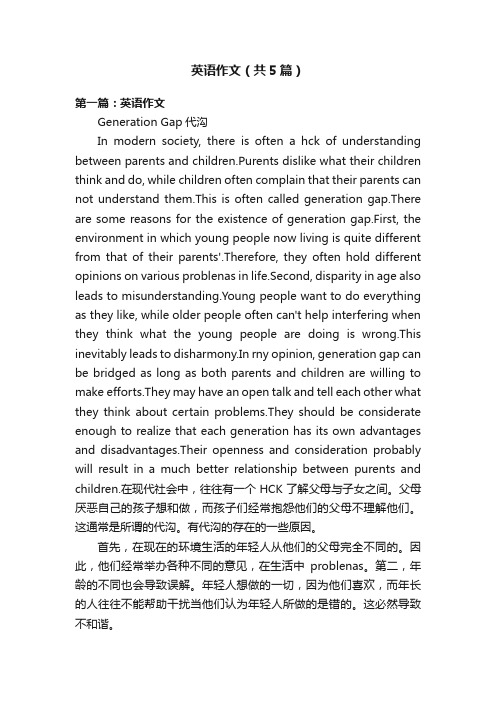
英语作文(共5篇)第一篇:英语作文Generation Gap代沟In modern society, there is often a hck of understanding between parents and children.Purents dislike what their children think and do, while children often complain that their parents can not understand them.This is often called generation gap.There are some reasons for the existence of generation gap.First, the environment in which young people now living is quite different from that of their parents'.Therefore, they often hold different opinions on various problenas in life.Second, disparity in age also leads to misunderstanding.Young people want to do everything as they like, while older people often can't help interfering when they think what the young people are doing is wrong.This inevitably leads to disharmony.In rny opinion, generation gap can be bridged as long as both parents and children are willing to make efforts.They may have an open talk and tell each other what they think about certain problems.They should be considerate enough to realize that each generation has its own advantages and disadvantages.Their openness and consideration probably will result in a much better relationship between purents and children.在现代社会中,往往有一个HCK了解父母与子女之间。
英语作文及中文翻译(优秀5篇)

英语作文及中文翻译(优秀5篇)(经典版)编制人:__________________审核人:__________________审批人:__________________编制单位:__________________编制时间:____年____月____日序言下载提示:该文档是本店铺精心编制而成的,希望大家下载后,能够帮助大家解决实际问题。
文档下载后可定制修改,请根据实际需要进行调整和使用,谢谢!并且,本店铺为大家提供各种类型的经典范文,如计划报告、合同协议、心得体会、演讲致辞、条据文书、策划方案、规章制度、教学资料、作文大全、其他范文等等,想了解不同范文格式和写法,敬请关注!Download tips: This document is carefully compiled by this editor. I hope that after you download it, it can help you solve practical problems. The document can be customized and modified after downloading, please adjust and use it according to actual needs, thank you!Moreover, our store provides various types of classic sample essays, such as plan reports, contract agreements, insights, speeches, policy documents, planning plans, rules and regulations, teaching materials, complete essays, and other sample essays. If you would like to learn about different sample formats and writing methods, please stay tuned!英语作文及中文翻译(优秀5篇)在我们平凡的日常里,大家都经常接触到作文吧,作文是从内部言语向外部言语的过渡,即从经过压缩的简要的、自己能明白的语言,向开展的、具有规范语法结构的、能为他人所理解的外部语言形式的转化。
英语作文优秀范文五篇

英语作文优秀范文五篇【导语】英语作文,是指用英语针对某一内容写出一篇文章,是英语考试最常见的一种题目类型,本店铺为你整理了《英语作文优秀范文五篇》希望可以帮到你!【篇一】英语作文优秀范文Before I was five years old, my parents gave me what I wanted, but as I became bigger, they changed their attitude towards me. My parents no longer satisfy me with all I want. When I want to buy a new dress, my mother won t buy for me directly, she asks me to do something to exchange for it. Such as doing the housework or making progress in the study. What s more, when I meet the difficulties, my parents won t solve them for me immediately, instead, they will leave me to think about them and help me to solve them. What my parents do to me is right, it is my road to grow up.在我五岁以前,我的父母给予我想要的东西,但是随着我长大,他们对待我的态度发生了改变。
我的父母不再满足我想要的一切。
当我想要买一条新裙子,妈妈不会立刻买给我,她会要求我去做一些事情,以此来交换。
比如做家务或者学习上有所进步。
而且,当我遇到困难了,我的父母不会立刻帮我解决,相反地,他们让我自己思考问题,然后帮助我解决。
英语作文简短五篇带翻译
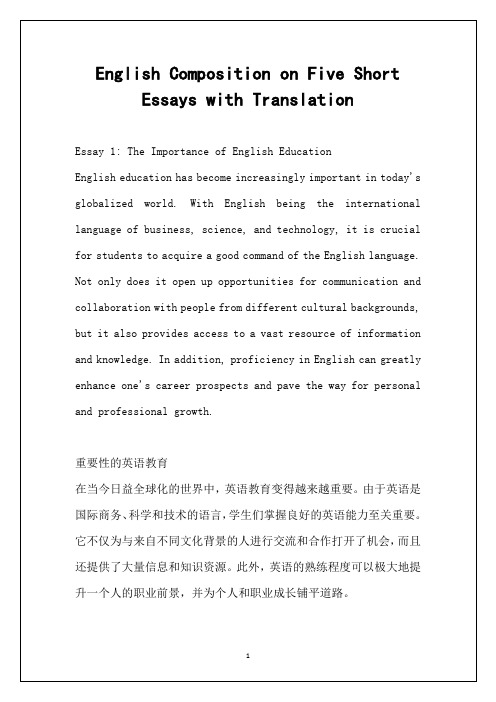
阅读英语文学不仅令人愉悦,而且对语言习得和个人发展有益处。文学使读者接触到各种各样的词汇、惯用表达和句式结构,增强他们的语言能力。此外,通过对不同主题、人物和情境的探索,读者可以洞察人性和经历,拓宽他们的视角,培养同理心。此外,文学可以激发创造力和批判性思维,启发读者反思自己的生活和周围的世界。
写好英语作文的艺术
写好英语作文需要结合批判性思维、创造力、组织能力和表达清晰的技能。作家们必须清楚地理解他们作文的主题和目的,以及目标受众。他们必须能够用恰当的词汇和语法有条理地、有说服力地表达他们的想法。此外,有效地运用文学手法和技巧可以极大地提升作文的质量,使之引人入胜,让读者铭记。
Essay 3: The Benefits of Reading English Literature
流利英语口语的力量
流利地讲英语是一种宝贵的技能,可以打开无限的机会之门。它使个人能够参与有意义的对话,参加国际活动,并与来自不同背景的人建立联系。此外,英语的流利可以提高一个人的自信、沟通能力和整体认知能力。它还可以促进在讲英语的国家旅行、工作和学习,提供更广泛的体验和知识。
Essay 5: Overcoming Challenges in Learning English
Reading English literature is not only enjoyable but also beneficial for language acquisition and personal development. Literature exposes readers to a wide range of vocabulary, idiomatic expressions, and sentence structures, enhancing their language skills. Moreover, through the exploration of different themes, characters, and settings, readers can gain insights into human nature and experiences, which can broaden their perspective and cultivate empathy. Additionally, literature can spark creativity and critical thinking, and inspire readers to reflect on their own lives and the world around them.
- 1、下载文档前请自行甄别文档内容的完整性,平台不提供额外的编辑、内容补充、找答案等附加服务。
- 2、"仅部分预览"的文档,不可在线预览部分如存在完整性等问题,可反馈申请退款(可完整预览的文档不适用该条件!)。
- 3、如文档侵犯您的权益,请联系客服反馈,我们会尽快为您处理(人工客服工作时间:9:00-18:30)。
One winter day in 1891, a class at a training school in Massachusetts, U.S.A, went into the gym for their daily exercises. Since the football season had ended, most of the young man felt they were in for a boring time.
But their teacher, James Nasmith had other ideas. He had been working for a long time on a new game that would have the excitement of the American football. Nasmith showed the men a basket he had hung at the each end of the gym, and explained that they were going to sue a round European football, at first everybody tried to throw the ball into the basket no matter where he was standing. “Pass! Pass!” Nasmith kept shouting, blowing his whistle to stop the excited players. Slowly, they began to understand what was wanted of them. The problem with the new game, which was soon called “basketball”, was getting the ball out of the basket. They used ordinary food baskets with bottoms and the ball, of course, stayed inside. At first, someone had to climb up every time a basket was scored. It was several years before someone came up with the idea of removing the bottom of the basket and letting the ball fall through. There have been many changes in the rules since then, and basketball has become one of the world’s most popular sports.
Passage Two 源自The word “university” comes from the Latin word “universitas”, meaning “the whole”. Later, in Latin legal language, “universitas” meant a society or corporation. In the Middle Ages, the word meant “ an association of teachers and scholars”. The origins of universities can be traced back to the 12th to14th centuries. In the early 12th century, long before universities were organized in the modern sense, students gathered together for higher studies at certain centers of learning. The earliest centers in the Europe were at Bolonia in Italy, founded in 1088. Other early centers were set up in France, the Czech Republic, Austria and Germany from 1150 to 1386. The first universities in Britain were Oxford and Cambridge. They were established in 1185 and 1209 respectively. The famous London University was founded in 1836. This was followed by the foundation of several universities such as Manchester and Birmingham, which developed from provincial colleges. It was in the 1960’s that the largest expansion of higher education took place in Britain. This expansion took 3 basic forms: existing universities were enlarged, new universities were developed from existing colleges and completely new universities were set up. In Britain, finance for universities comes from three source: the first, and the largest source, is grants from the government, the second source is fees paid by students and the third one is private donations. All the British universities except one receive some government funding. The exception is Buckingham, which is Britain’s only independent university.
Dear Students,
Here are five passages here for you to read, which share the same topic about learning and education. You have to finish your reading by the end of the first period. What your are going to do is to try to get a main idea of each passage. For the next period, we will conduct a series of relevant discussions and writing about it.
An educated mother, on the other hand, has greater earning abilities outside the home and faces an entirely different set of choices. She is likely to have fewer but healthier children and can insist on the development of all her children, ensuring that her daughters are given a fair chance. The education of her daughters then makes it much more likely that the next generation of girls, as well as of boys, will be educated and healthy. The vicious circle is thus transformed into a virtuous circle.
Few will dispute that educating women has great social benefits. But it has enormous economic advantages as well. Most obviously, there is the direct effect of education on the wages of female workers. Wages rise by 10 to 20 per cent for each additional year of schooling. Such big returns are impressive by the standard of other available investments, but they are just the beginning. Educating women also has a significant impact on health practices, including family planning.
Passage One
Educating girls quite possibly yields a higher rate of return than any other investment available in the developing world. Women’s education may be unusual territory for economists, but enhancing women’s contribution to development is actually as much an economic as a social issue. And economics, with its emphasis on incentives (激励), provides guideposts that point to an explanation for why so many girls are deprived of an education.
